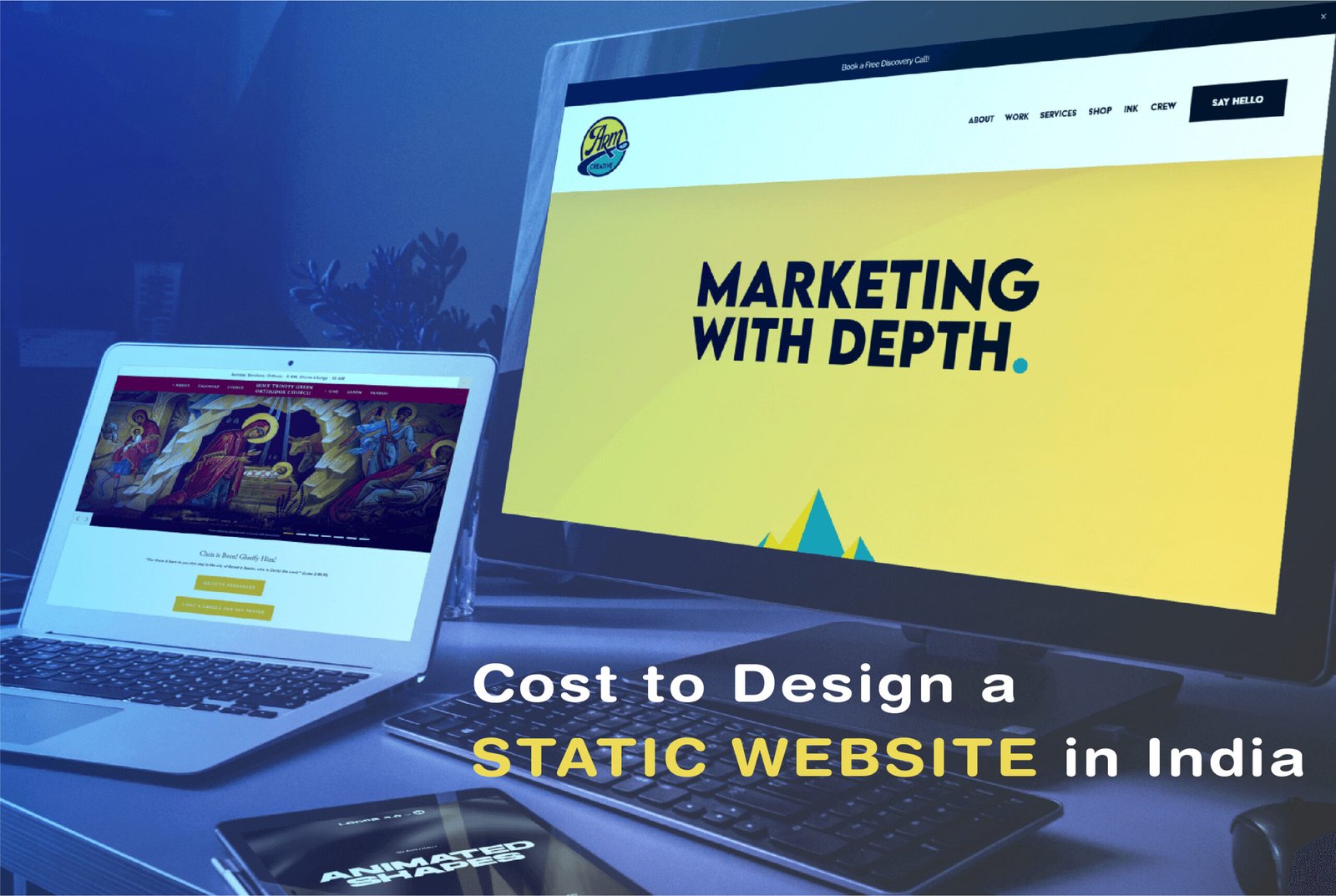Static website cost is one of the cheapest solutions that businesses and individuals can pursue to establish their web presence without requiring dynamic features or frequent updates. Static websites are often chosen by startups, small businesses, freelancers, and portfolio sites.
Static websites are a must-have tool for any business or person who is ready to take space in the world wide web. And among all types of websites, this type stands out because of its simplicity, speed, and cheapness, while dynamic websites, using databases and server-side processing, comprise fixed HTML pages and provide the same content to each visitor. Hence, these make the best for one who requires a basic online presence without complicated features or frequent updates.
Static website design are becoming very popular in India because their developmental and maintenance costs are relatively lower than other forms of websites, making them a worthy asset for small businesses, freelancers, and startups.
1. Understanding Static Websites
A static site is a group of fixed, HTML pages that show the same information to all visitors. Static websites are not, as dynamic sites whose content is likely to update in real-time, static and have to be updated by hand for any changes .
Static Website Benefits:
- Speed: Static websites are faster because they don’t have to use server-side processing for rendering.
- Security: Static sites are somewhat more secure in the sense that they do not have any database or backend system that hackers can steal into.
- Ease of Maintenance: The updates are easy to put in place and less frequent, thereby being more convenient.
- Cost-Effective: Since the development and hosting rates are low, small-scaled projects find static websites in India to be cost-effective.
2. What Affects the Cost of Developing a Static Website
Break down of factors affecting the designing of a static website site are as follows:
Number of Pages and Complexity:
- Single-Page Websites: Single-page websites are relatively cost-friendly since it requires much lesser coding and content.
- Sites that have multiple pages, such as Home, About, Services, Contact require more work, which makes them costly
- Rigidity: Complex designs, interactive elements, and custom animations are pricey
Design Approach:
- Template-based Design: A template based design is cheaper but lacks originality.
- Custom Design: A custom design is often pricier since the designer spends special design time on your project, and it’s tailored especially to your brand and style.
- Responsive Design: The website should be desktop, mobile, and tablet friendly. That’s a must for UX but adds to design cost.
Content Creation:
- Text and Graphics: High-quality content is mixed with professional images, so the website looks rich and feels great. If you need any help with content writing, photography, or custom graphics, that’s going to increase the cost.
- SEO-optimized Content: Many will spend money on SEO-optimized text, which may have to be paid additionally.
Hosting and Domain Registration:
- Hosting: The hosting isn’t much for static websites. This amounts cheaper in the annual hosting.
- Domain Registration: Any domain name, such as .com, .in, would serve for around INR 500 to INR 1,500 per year.
Extra Features:
- Interactive Features: Simple forms, image sliders, galleries, or animations mean additional coding and design work is needed, so it will be charged more.
- Developer Experience and Location:
- A Freelance Web Developer vs. Agency: Hiring a freelance might be cheaper, but a top-rated design agency will cost more because of higher quality, reliability, and support.
More experienced developers will cost more, however, they have the knowledge of the industry and can make the project better and more efficient.
3. Cost in India: Static Websites
Now, with all the above in mind, here are some general static website price in India:
Simple Single Page Website:
Price Range: INR 3,000 to INR 10,000
Information: Ideally appropriate for portfolios, landing pages, or even simple online brochures. Cannot be more than a few pages, primarily with a basic piece of information and very basic layout.
Multi-Page Basic Website, 3-5 pages:
Price Range: INR 10,000 to INR 20,000
Details: Customized Multi-Page Website (5+ pages):
Approximate Price Range: INR 10,000 to 50,000
Details: Offers customized designs, branding elements, and medium levels of search engine optimization. It’s the best option for businesses that want strong web presence.
High-End Static Websites with Premium Features:
Approximate Price Range: INR 50,000 and above
Details: Sophisticated design, animations, or aesthetic styles. Suitable for companies requiring brand definition and high-classed work of design.
4. Static Website Cost Break-down
Here’s a very simple breakdown of what one might expect to pay for the cost of designing a static website :
Design and Development:
Template-Based Design: Low designs: INR 2,000 to INR 5,000
Custom Design: Unique to a business: INR 10,000 to INR 25,000.
Development: The cost of coding and setup are variable, which could be between INR 3,000 to INR 15,000, depending upon the complexity and experience of the developer.
Content:
Writing: Content writing services could, for example, cost around INR 500 to INR 1,500 per page.
Images/Graphics: Stock photos can range from INR 200 per image, while custom graphics could range much higher
SEO Optimization:
Basic SEO: Basic search engine optimization will range between INR 1,000 to INR 5,000 for meta descriptions, image tags, and page titles.
Hosting and Domain:
Hosting: Shared hosting starts from around INR 1,000 per year, while VPS hosting can start from INR 3,000 per year, depending on the provider.
Domain: This could normally range between INR 500 to INR 1,500 per year for a.com or.in domain.
5. DIY vs. Hiring a Professional
You can either do it yourself using website builders or hire a professional. Here is the comparison:
DIY with Website Builders:
Platforms like Wix, Squarespace, and WordPress offer tools that are beginner-friendly for creating static websites. This is cheaper for those with basic tech skills and requires a lower budget.
Hiring a Professional:
Advantages: Professional website designers have experience, saving you time and guaranteeing quality. They also know the web designing standards, usability, and optimization; therefore, they’ll create a user-friendly one.
Disadvantages: It would be costlier because a professional is being employed, but this would be less expensive in the long run for companies that want to become popular online.
6. How to Save on a Static Website Design
Here are some ways to control website design costs:
- Templates: Use templates. Avoid custom design to save on cost.
- Fewer Pages and Features: Stick to the most necessary features and pages for a quicker, cheaper development time.
- Write and Provide Your Content: If possible, write and provide your own content and photos.
- Limit the Number of Revisions: Clearly define your vision at the start to avoid costly revisions.
- Cost-Effective Hosting: Shared hosting plans are more than enough for a simple site but a much cheaper price.
7. Estimation of Long Term Maintenance Costs
A static website maintenance is inexpensive since it does not require functionalities. Some costs may be periodical, however:
- Hosting and Domain Renewal: INR 1,500 to INR 5,000 per year.
- Content Updates: Changes or new content might cost between INR 500 and INR 2,000 per update.
- SEO and Performance Maintenance: Basic check-ups on SEO and performance may be done annually for a pittance of a sum.
Conclusion
A static website in India permits anyone or a business to set up a strong and reliable presence in the online world without the periodic cost burdens of dynamic web solutions. Of course, the cost would depend on design intricacy, content kind, and technical expertise of the developers. In any case, static websites are often cheap for anyone desiring simplicity and reliability. A well-constructed static site, whether built by you or by other professionals, is surely to satisfy most small business, portfolio, and information websites. By understanding these factors which affect cost, you can make smart decisions to create a website that, long-term, will allow little to no maintenance and produces high performance.



